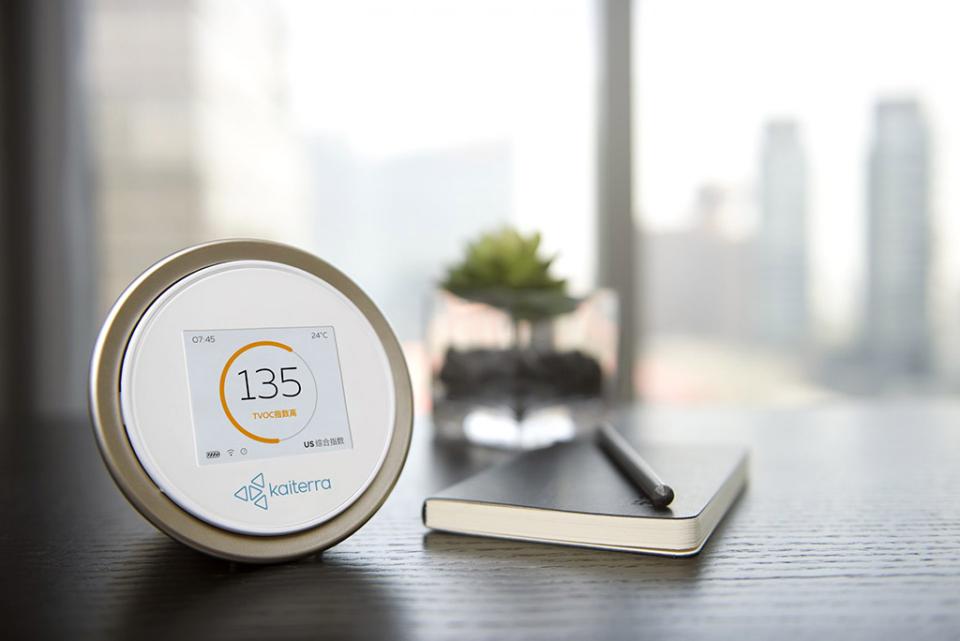Surviving the Airpocalypse
Growing up in Canada, Jessica Lam and her husband Liam Bates were aware of air pollution, but regarded it from a distance as a big-picture issue for scientists and policymakers.
When they moved to Beijing in 2014, they entered a world where pollution is as much a part of daily life as the afternoon forecast, where technical jargon like “air quality index” and “particulate matter 2.5” are household words and people are sure to check the smog level before going for a walk in the park.
“You’ve heard of the ‘Airpocalypse’?” Bates asks, referring to a nickname for Beijing’s notorious oceans of smog that settle over the city, sometimes closing schools and roads. “There was a period of about a week where it could be noon, and it was basically dark outside.”
Lam and Bates realized that, barring expensive commercial equipment, there was little the average person could do to check the air quality in their own home. “The only thing you could do was buy a special lab instrument,” Bates explains. “This expensive thing with cables and an antenna coming out of it. It’s not practical.” Their startup -- Kaiterra -- would become an industry pioneer in household air monitors that make checking pollution levels as simple as glancing at the clock.
With a target market of, basically, anyone who breathes air, Kaiterra has sold tens of thousands of units in China and has recently opened an office in New Delhi, a city in the running for the title of world’s dirtiest air. Eventually Lam and Bates hope to use the collected data from these monitors to help study and fight an environmental problem that the World Health Organization claims kills 8 million people each year.
Into the smog
Bates and Lam are not environmental scientists, or even engineers. Lam was studying accounting when they met at UBC, and while Bates was an Asian studies major who spoke fluent Mandarin, he was more interested in Kung Fu than air quality, and spent his first few years in China as a TV personality, hosting documentary shows for Travel Channel China and the Discovery Channel.
Bates put his TV career on hold while he and Lam identified a third co-founder, assembled a team of engineers and launched their first company, Origins Technology, from their living room. “Sometimes we would wake up, walk out and the hallway would be full of people,” says Bates.
Bates was an Asian studies major who spoke fluent Mandarin, he was more interested in Kung Fu than air quality, and spent his first few years in China as a TV personality.
The team did not invent new technology as much as miniaturize the cumbersome equipment normally used in labs. The Laser Egg, their flagship product, is a sleek white device about the size of an alarm clock that pulls air into itself and uses laser-based light scattering to measure the size and number of foreign particles.
The findings are displayed as a single number, which is the air quality index (AQI), a measure that ranges from 1 to 500. See a 12 on the screen, and you probably have nothing to worry about. See a 254, and it’s time to change the air filter -- or close the window.
“A lot of our clients own air purifiers. They buy the Laser Egg to see if it is working,” Bates says. “You can actually walk the Egg around your house to see where the problem is coming from.”
Identifying the source of bad air is one of the most difficult parts of combating air pollution. In Montreal (with an AQI of 24 at the time of writing), home air pollution tends to come from within — such as cigarette smoke or fireplace soot. In Beijing (AQI 94 at the time of writing), the worst pollution usually comes from the outside.
The latter example is obviously more concerning, and not only because Beijing’s AQI is worse than Montreal’s. Outdoor, or “ambient,” air pollution (which the WHO claims kills 4.2 million people each year — more than HIV, tuberculosis and malaria combined) is vastly more difficult to trace. The PM (particulate matter) 2.5, ozone and other pollutants floating around a Beijing neighborhood might come from a trash fire in the back alley, or from a steel mill 30 miles away.
Global environmental science, crowdsourced
“There is a giant lack of information,” Bates says. “Most cities around the world have absolutely no idea where there pollution comes from.”
Ambient air pollution in India kills as many as 1.5 million people per year, according to the WHO, and the country leads the world in deaths from chronic respiratory disease and asthma. In New Delhi, where Kaiterra has its second office, officials blamed automobiles for the city’s endemic smog. In 2016 the city launched a trial program that banned half of registered vehicles on any given day. But a study conducted by journalism network IndiaSpend found that pollutant levels actually rose 15 percent during the car ban.
Instead, independent researchers blamed exhaust from coal-fired and thermal power plants, which remain lightly regulated.
“You really can’t compare a city like LA to a city like New Delhi, because there is really nothing similar between them,” Bates continues.
But tens of thousands of personal cloud-connected air monitors scattered throughout a city might prove to be a powerful new tool to map and understand air pollution.
“Imagine you’ve got 20,000 people living in a city, all using devices like this to measure air quality. From the data these devices are taking and their location, we can see which parts are the most polluted,” Bates says.
Monitoring the cultural atmosphere
Lam, who manages Kaiterra’s accounting and marketing, among other duties, says that people can choose whether or not they want to share their air quality data, but they rarely have a problem with it.
“Without data and information, you can’t make any form of policy change,” she says. “I think certainly, at least from a consumer perspective, that would be something they would be excited about.”
Lam spends a lot of time thinking about how to get the digital generation excited about air quality monitoring. Engaging them involves more than simply learning to use WeChat (the most popular social media app within China’s Great Firewall).
People in China simply navigate internet differently, Lam explains. Basics things like web page menus and the locations of buttons on a smartphone app follow different norms and standards than in the West. Simply translating an American-style interface into Chinese will still leave the average user confused.
“If I say, ‘Oh, the American experience is so clean, so functional, why should I localize? Why should I change?’ That’s the first thing you have to throw out the window,” Lam says.
Lam argues that China is a graveyard of failed foreign startups that simply refused to abandon their Western assumptions, and even juggernauts like Amazon and Airbnb are routinely beaten out by local competitors that simply fit better with Chinese expectations.
She argues that China is a graveyard of failed foreign startups that simply refused to abandon their Western assumptions, and even juggernauts like Amazon and Airbnb are routinely beaten out by local competitors that simply fit better with Chinese expectations.
“There is so much nuance that doesn’t get covered [abroad] that you really have to be here to understand,” Lam explains. “In China, if you were born in the 90s, in the 80s, in the 70s…each set of ten years has actually changed in values, consumer habits, stuff around filial piety, the way they feel about individualism, how they express themselves.”
Fortunately, Lam continues, for the younger generations leading a healthy lifestyle — whether through exercise, eating well or having a good AQI in their home — is becoming ingrained into the “successful adult” ideal.
“The trend nowadays is not only having a cool car or cool clothes, it’s about having a sexy body as well — the physical aspect. And that’s more of a trend in China in general.”
“If we can tackle China and India,” she says, “on the whole that’s a large change globally. That’s what keeps me excited.”
But for now, Lam and Bates are focused on getting as many air quality monitors into as many homes as possible — and outpacing the copycats.
The Chinese tech industry is basically the Wild West for intellectual property, and as soon as Kaiterra’s products began to gain traction in the market, rip off versions appeared to undercut them. Surprisingly enough, Lam and Bates prefer it this way.
The Chinese tech industry is basically the Wild West for intellectual property, and as soon as Kaiterra’s products began to gain traction in the market, rip off versions appeared to undercut them.
Surprisingly enough, Lam and Bates prefer it this way.
“That’s the exciting part, right?” Lam says. “You can’t wait behind a wall and say ‘Oh, you can’t cross this wall, so we have an advantage.’ That’s not how a competitive market works. You can’t just [rest] on your laurels and wait.”
So far, Kaiterra has managed to stay ahead. Laser Egg is on its third iteration (the Laser Egg 2+) and is even available in Apple Stores in China. Online, the company receives orders from other parts of Asia, the Americas and Europe (which itself has around 500,000 deaths per year due to air pollution).
One organization based in the Caribbean ordered a number of devices to monitor the smoke contamination from large-scale garbage burning. One woman in Switzerland ordered a Laser Egg to prove in court that cigarette smoke from a new bar was contaminating the air in her home.
“When we started, I thought that air pollution was a China problem,” Bates continued. “It’s really not. It’s a worldwide problem.”

































